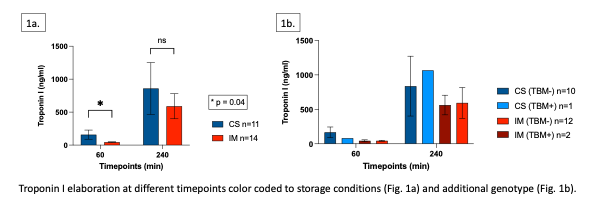Significant Reduction of Troponin I Elaboration After Ischemia Minimization in the First Hour of Ex Vivo Xeno Heart Perfusion
1Center for Transplantation Sciences, Massachusetts General Hospital, Cambridge, MA, 2eGenesis Inc., Cambridge, MA
Meeting: 2022 American Transplant Congress
Abstract number: 1528
Keywords: Heart, Ischemia, Perfusion
Topic: Basic Science » Basic Science » 13 - Xenotransplantation
Session Information
Session Time: 7:00pm-8:00pm
 Presentation Time: 7:00pm-8:00pm
Presentation Time: 7:00pm-8:00pm
Location: Hynes Halls C & D
*Purpose: Previous studies showed that ischemia minimization (IM), accomplished by perfusing the heart xenograft during storage, prevents ‘initial cardiac xenograft dysfunction’ (ICXD) and enables prolonged survival following in vivo orthotopic cardiac xenotransplantation. Here we report initial observations in a model designed to evaluate effects associated with IM and genetic modifications on myocardial injury in a working ex vivo model of ICXD.
*Methods: Hearts from genetically modified (GM) and wildtype (WT) pigs were procured after flushing with cold preservation solution (UW, 4oC) and stored for 3 hours either in cold saline (0.9%, 4oC: cold storage (CS)) or were perfused with oxygenated Steen’s solution with RBCs (IM). The GM hearts had ‘knockouts’ of three carbohydrate genes (GTKO, CMAHKO, β4GALNT2KO: TKO), some with additional expression of human thrombomodulin (TKO.hTBM); or GTKO with expression of hCD55 (GTKO.hCD55). Troponin I was used as a marker for myocardial injury, measured at pre-defined intervals during perfusion with freshly collected heparinized whole human blood in an established working heart model.
*Results: In total, 25 hearts were perfused ex vivo, 11 with CS (TKO n=7, TKO.hTBM n=1, GTKO.hCD55 n=1, WT n=2), and 14 with IM (TKO n=11, TKO.hTBM n=2, WT n=1). Mean troponin I elaboration was significantly reduced after 1 hour of ex vivo perfusion in the IM group (44.8 ng/mL vs. 231.1 ng/mL; p = .04), but not after 4 hours (Fig. 1a). Whether hTBM delays troponin release after CS (mean Troponin I in CS group 246.1 [+/- 330.7] ng/mL, n= 10, vs. 82ng/mL, n=1; Fig. 1b) requires additional observations.
*Conclusions: IM significantly decreased initial myocardial injury during the first hour relative to CS, reflecting protection from ICXD; expression of hTBM may also confer ICXD protection for TKO hearts after CS. On average IM did not significantly reduce myocardial injury (ICXD) by 4hr relative to CS; influence of heart phenotype on ICXD remains under study. We provisionally conclude that IM and perhaps hTBM attenuate ICXD of genetically modified pig hearts during initial exposure to human blood.
To cite this abstract in AMA style:
Pollok F, Connolly MR, Calhoun A, Habibabady Z, Miura S, Ma M, Pratts S, Burdorf L, Kan Y, Layer JV, Layer JV, Tan E, Anand R, Li M, Hall KC, Youd ME, Stiede K, Qin W, Curtis M, Azimzadeh A, Pierson RN. Significant Reduction of Troponin I Elaboration After Ischemia Minimization in the First Hour of Ex Vivo Xeno Heart Perfusion [abstract]. Am J Transplant. 2022; 22 (suppl 3). https://atcmeetingabstracts.com/abstract/significant-reduction-of-troponin-i-elaboration-after-ischemia-minimization-in-the-first-hour-of-ex-vivo-xeno-heart-perfusion/. Accessed December 12, 2025.« Back to 2022 American Transplant Congress

